FUN WITH TESSELLATION AND GRAPHIC ARTS
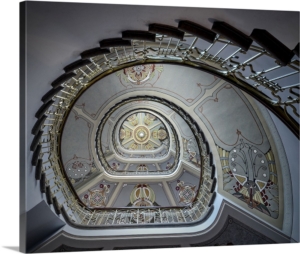
The game “What Historical Figure Do You Want to Meet” made me think of whom I’d like to talk to. One is M.C. Escher, and the second person is the Egyptian Pharaoh Akhenaten.
If I could resuscitate the pharaoh, I’d ask where he conceived the idea of monotheism. Was Akhenaten truly the first person to consider only one God? ¹ Did he merely rebel against the pantheon of Egyptian deities and try to change Egyptian religion to be clever? Or to leave a legacy? Did he experience a mystical experience?
Interesting as Akhenaten sounds, I’ll leave him for a future blog.
Escher, who died in 1972, is a more recent figure to investigate. One of Escher’s main bodies of work includes his exercises in tessellation, geometric shapes repeated on a flat plane without leaving gaps, where shapes, like squares and triangles, interlock with each other in perfect harmony. (See figure below)
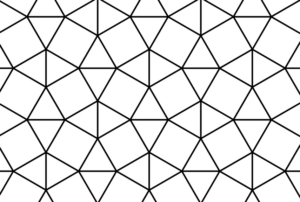
Tessellation, or periodic tiling, has roots in the ancient cultures of Sumer, Rome, Greece, and Egypt. Yes, even in Akhenaten’s Eighteenth Dynasty, tessellation adorned the floors and walls of homes and temples. It’s fascinating to see that the repetition of shapes from the ancient Egyptian civilization are precursors to Escher’s work. (Below – a pavement fragment from a palace floor in Amarna, Egypt – Eighteenth Dynasty)
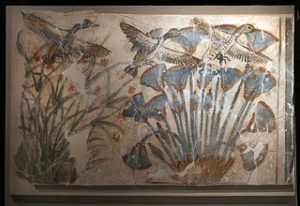
Escher is famous for taking rigid geometric forms, such as triangles, and evolving them into fish or birds or butterflies. (See below)
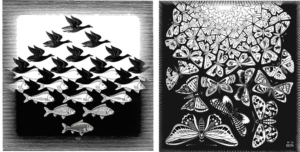
All creative people, writers, visual artists, and musicians, have “defining moments” that impact their work. Escher was no different. He experienced his “defining moment” at the Alhambra. While there, he copied geometric designs including honeycombs in the Patio de los Leones (Above). The experience took him from simple observation of geometric forms to focusing on his own inventiveness and his art flourished into fantastic optical illusions. (See below)
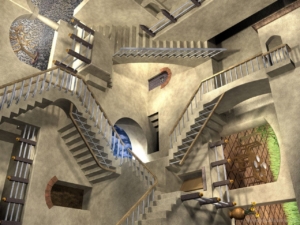
The digital age influences every facet of life. Art is no exception. With computers, the repetition of patterns used in graphic art is totally fused with math and science. It also impacts architecture. (See below – Swiss Re Tower in London)

A computer calculates a complex tessellation in seconds.
Escher did his work the old-fashioned way—without computers. If he were alive today, would Escher create complex tessellations using computer technology? Or would he continue in the artisan tradition of pen to paper using his human imagination?
¹Moses presumably lived one hundred or more years after Akhenaten
***
I’d love to hear what you think of tessellation?
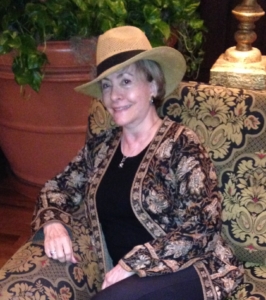 I love tessellation so much that I’ve described buildings, churches, or pathways containing tessellation in a couple of my novels. Readers would probably not remember the descriptions since they are merely part of a setting I’m describing.
I love tessellation so much that I’ve described buildings, churches, or pathways containing tessellation in a couple of my novels. Readers would probably not remember the descriptions since they are merely part of a setting I’m describing.
About Kathryn
Kathryn Lane writes mystery and suspense novels set in foreign countries. In her award-winning Nikki Garcia Mystery Series, her protagonist is a private investigator based in Miami.
A bit of News: Fun in Galveston, TX
Three members of the Stiletto Gang, Saralyn Richard, Gay Yellen, and Kathryn Lane are among the eight authors represented at the Book Nook at the Galveston Chamber of Commerce’s 15th annual Women’s Conference.


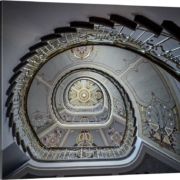

Kathryn, I’ve always enjoyed getting lost in an Escher etching. One thing I’ve noticed over the last few years is that tessellation has gotten big in home design, especially in patterned floor and wall tiles.
Lois, it has influenced home design! And I love seeing it despite the fact that I’m more of a traditionalist in my own home. Escher’s work was fascinating, and I wonder how he could do those incredible designs without a computer – what a brain he must have had!
Thanks for this fascinating post, Kathryn. Escher’s work has inspired the world of design and many great thinkers, including you and me! Thanks for the nod to the Book Nook, too. 🙂
Thanks, Saralyn. In my newsletter that also went out today I mentioned your latest book, which I hope to start reading soon!
Always interesting.
Thank you! Glad you enjoyed it.
I’d seen this type of work (and Escher’s in particular), but really hadn’t thought about the complexity of how he did it. Very interesting piece.
Looks like the Book Nook was well represented by the 3 of you !
Debra,
Thanks! I always loved Escher’s work and have come to appreciate it even more as I’ve realized he did not have any computers to work out the intricacies of his designs.
It was pretty amazing to have the Saralyn, Gay and me in one location like that! We’ve been together a couple of times before, but for different reasons, not for a book event where the three of us had booths.
Textile artists have made fantastic quilts based on Escher’s design concepts. Loved your post.
Thank you, Barb. It was fun to write it!
So interesting, Kathryn! I will look for those tessellation descriptions! I imagine our attraction is related to nature’s obsession with the fractal.
Traditionally, Abraham was the father of Hebrew monotheism (although the people didn’t always practice it according to archeological finds). He lived somewhere between 1800-1500 BCE. That’s a few hundred years before Akhenaten. The Jewish year is 5783. I agree, though, how fascinating that he deviated from ancient tradition to decide Ra was the only god…or perhaps the only god his people should worship. Even early Judaism seems to acknowledge the existence of other gods (You shall have no other gods BEFORE me.) That is not, of course, modern day thought, but maybe that was where Akhenaten was coming from.
T.K., thanks for the excellent reply. When I put my footnote in, I did it with great hesitation because I was relying on modern research and that tends to place Moses after Akhenaten. I’m sure biblical scholars would disagree (now that I’ve read your excellent explanation!).
Escher is my brother’s favorite artist. I’ve always found his work fascinating, too. The recent exhibit of his works at the Museum of Fine Arts here was almost overwhelming in scope. Hope you got a chance to see it.
Gay, your brother has great taste!
I have so many favorites that it’s hard to say who is my top favorite. Escher’s work and the scope of it is absolutely overwhelming. As I mentioned in the blog, I don’t know how he did it without computers and without being a mathematician, though his knowledge of math was extensive!
I love what yoou guys arre uup too. This sot off cleverr work aand reporting!
Keepp uup the excellent workjs gus I’ve incorporated yyou gus to mmy blogroll.